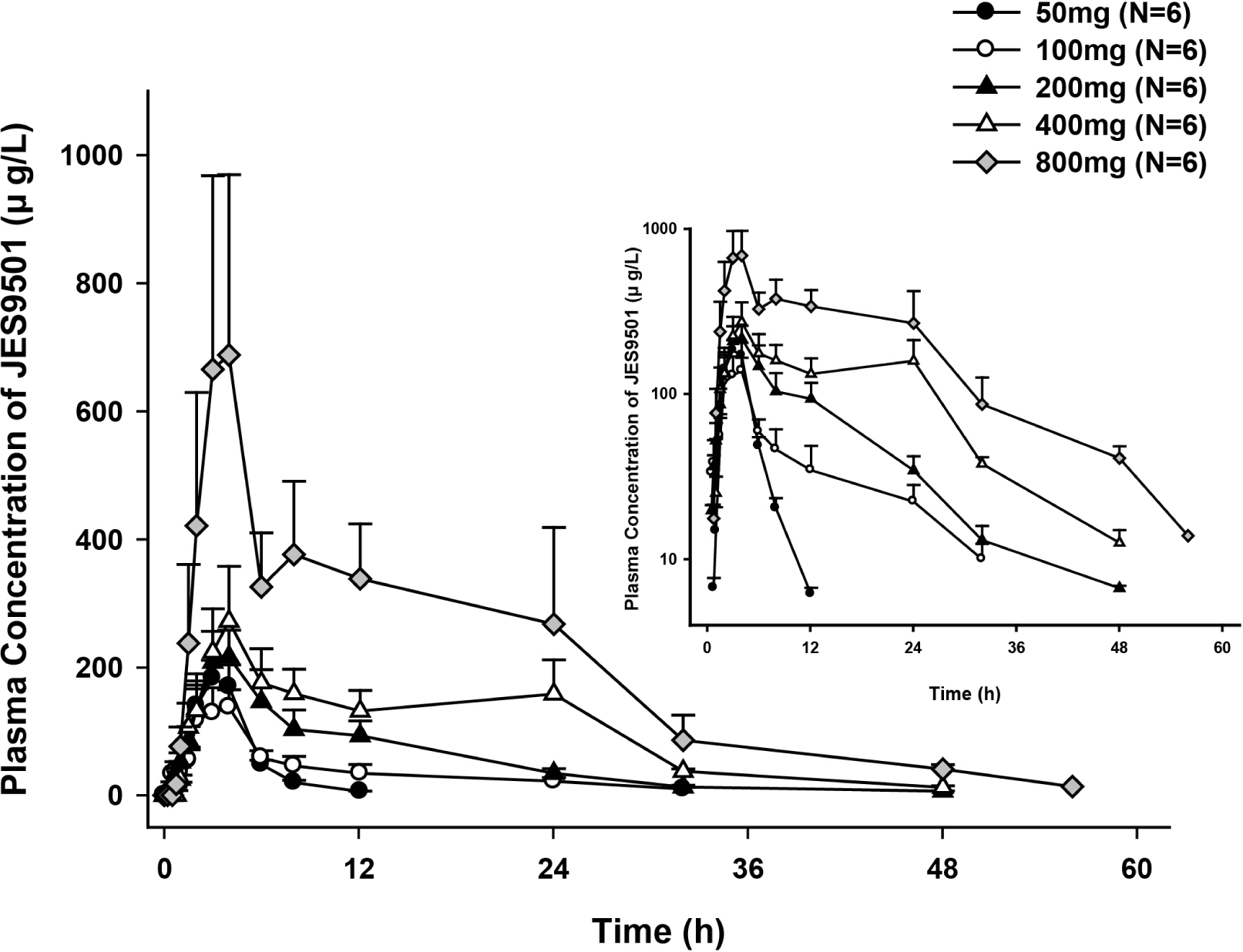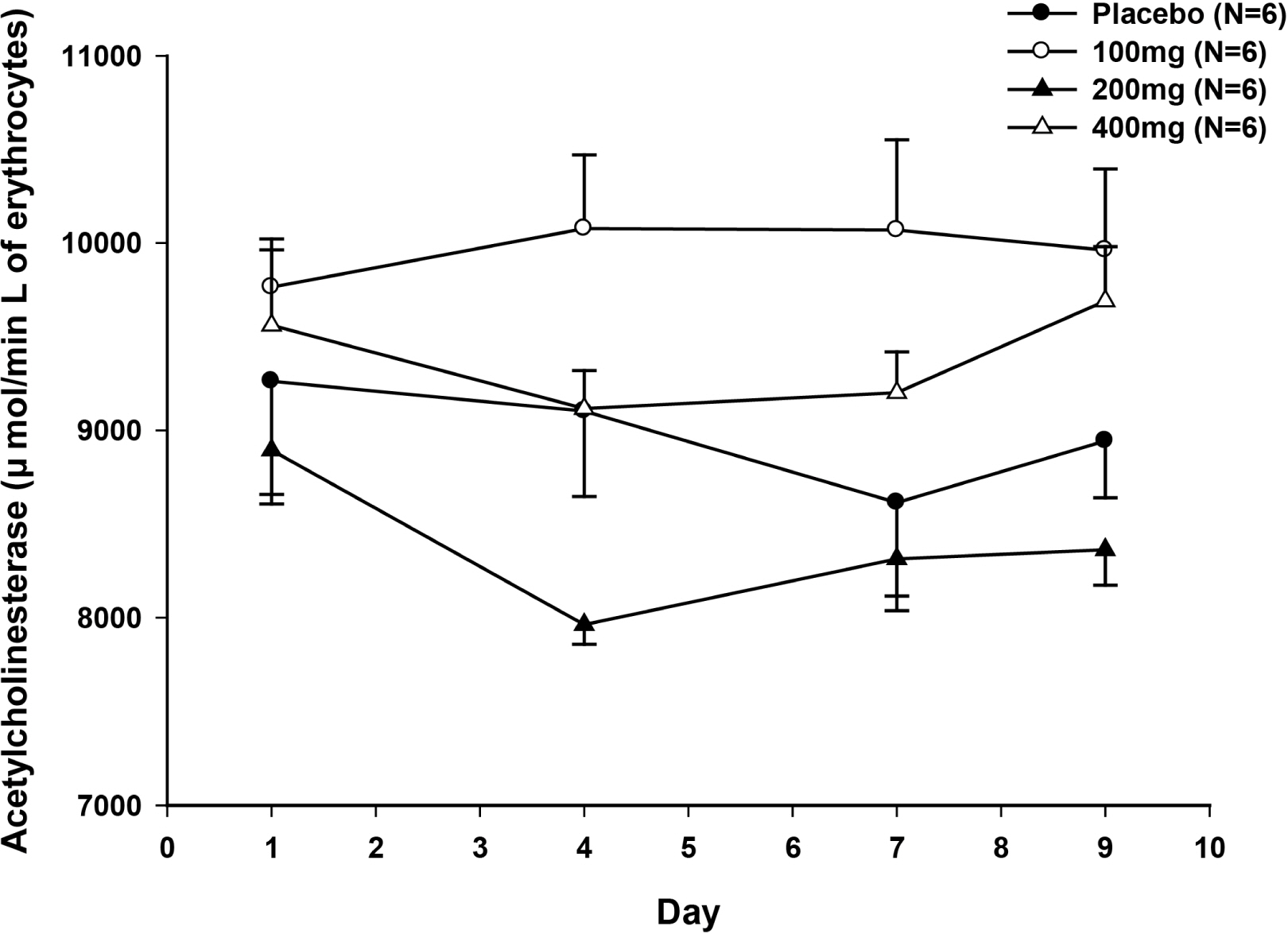J Korean Soc Clin Pharmacol Ther.
2013 Dec;21(2):141-149. 10.12793/jkscpt.2013.21.2.141.
Pharmacokinetics, Pharmacodynamics and Safety of JES9501 after Single and Multiple Oral Administration in Healthy Subjects
- Affiliations
-
- 1Department of Clinical Pharmacology and Therapeutics, Seoul National University College of Medicine and Hospital, Seoul, Korea.
- 2Department of Clinical Pharmacology and Therapeutics, Kyung Hee University Hospital, Seoul, Republic of Korea.
- 3Department of Clinical Pharmacology and Therapeutics, Seoul National University College of Medicine and Bundang Hospital, Seongnam, Korea. jychung@snubh.org
- KMID: 2203227
- DOI: http://doi.org/10.12793/jkscpt.2013.21.2.141
Abstract
- BACKGROUND
JES9501 is dehydroevodiamine, the extract of Evodia rutaecarpa, expected to be a new therapeutic for Alzheimer disease. This study aims to investigate the pharmacokinetics (PK), pharmacodynamics (PD) and safety of JES9501 after single or multiple dosing.
METHODS
A double-blind, randomized, placebo-controlled, dose ascending, parallel study was conducted in healthy subjects. A single dose of JES9501 50.100.200.400 or 800 mg and multiple doses of JES9501 100.200 or 400 mg once-daily for 7days was administered. Serial blood and urine samples for PK evaluation were collected. Acetylcholinesterase (AChE) activity was measured for PD evaluation in multiple dose group.
RESULTS
In the single dose study, means of dose-normalized peak concentration (Cmax) of 100.200.400 and 800 mg dose group are comparable except 50 mg dose group. Means of dose-normalized area under the plasma concentration-time curve (AUC) from dosing to the last quantifiable concentration of corresponding dose group were similar. At steady state in the multiple dose study, means of dose-normalized Cmax and AUC for dosing interval of 100.200 and 400 mg dose group decreased as the dose increased, however those were not relevant. There was no significant difference of AChE activity between three dosage groups and placebo group. Adverse events related to study drug were all mild and there were no remarkable findings.
CONCLUSION
JES9501 was safe and well-tolerated after single or multiple doses in healthy male subjects. Further studies are warranted to evaluate the PK of optimized dosage form and to prove the drug effect in clinical trials for Alzheimer disease patients.
MeSH Terms
Figure
Reference
-
1. Seoul National University Hospital. Nationwide Study on the Prevalence of Dementia in Korean Elders. 2008; (Korean).2. Han SH. Novel Pharmacotherapies for Alzheimer’s Disease. J Korean Med Assoc. 2009; 52(11):1059–1068. (Korean).
Article3. Williams P, Sorribas A, Howes M J. Natural products as a source of Alzheimer’s drug leads. Nat Prod Rep. 2011; 28(1):48–77.
Article4. Lee JY, Cha MR, Chois CW, Kim YS, Lee BH, Ryu SY. Cholinesterase Inhibitors Isolated from the Fruits Extract of Evodia officinalis. Kor J Pharmacogn. 2012; 43(2):122–126. (Korean).5. Lee SW, Hwang BY, Kim SE, Kim HM, Kim YH, Lee KS, Lee JJ, Ro JS. Isolation of modulators for multdrug resistance from the fruits of Evodia officinalis. Kor J Pharmacogn. 1995; 26(4):344–348. (Korean).6. Yun HJ, Heo SK, Lee YT, Park WH, Park SD. Anti-inflammatory effect of Evodia officinalis Dode in mouse macrophage and human vascular endotherial cells. Kor J Herbology. 2008; 23(1):29–38. (Korean).7. ORHAN İ, ŞENER B. Acetylcholinesterase Inhibitors from Natural Resources. FABAD J Pharm Sci. 2003; 28:51–58.8. Jeil Pharmaceutical Co., Ltd.Investigator’s Brochure. 2003; (Korean).9. FDA. Estimating the Maximum Safe Starting Dose in Initial Clinical Trials for Therapeutics in Adult Healthy Volunteers. Guidance for Industry. 2005.10. Mosca A, Ghezzi A, Luzzana M, Paleari R, Imbimbo BP. Pharmacodynamic monitoring of eptastigmine in capillary blood. Eur J Clin Pharmacol. 1996; 50(5):425–427.
Article11. Worek F, Mast U, Kiderlen D, Diepold C, Eyer P. Improved determination of acetylcholinesterase activity in human whole blood. Clin Chim Acta. 1999; 288(1-2):73–90.
Article12. Lotti M. Cholinesterase inhibition: complexities in interpretation. Clin Chem. 1995; 41(12):1814–1818.
Article13. Augustinsson K-B. The normal variation of human blood cholinesterase activity. Acta Physiol Scand. 1955; 35(1):40–52.14. Sidell FR, Kaminskis A. Influence of age, sex, and oral contraceptives on human blood cholinesterase activity. Clin Chem. 1975; 21(10):1393–1395.
Article15. Biagioni MC, Galvin JE. Using biomarkers to improve detection of Alzheimer’s disease. Neurodegener Dis Manag. 2011; 1(2):127–139.
Article16. Coley N, Andrieu S, Delrieu J, Voisin T, Vellas B. Biomarkers in Alzheimer’s disease: not yet surrogate endpoints. Ann N Y Acad Sci. 2009; 1180:119–124.17. Galasko D, Golde TE. Biomarkers for Alzheimer’s disease in plasma, serum and blood-conceptual and practical problems. Alzheimers Res Ther. 2013; 5(2):10.
- Full Text Links
- Actions
-
Cited
- CITED
-
- Close
- Share
- Similar articles
-
- Pharmacokinetics and pharmacodynamics of drugs for sedation
- A Randomized, Placebo Controlled, Double Blind, Parallel Group, Multiple Dosing, Dose Escalation Clinical Study to Evaluate Pharmacokinetics/Pharmacodynamics and Tolerability of Zofenopril in Healthy Korean Subjects
- Influence of Simvastatin on Pharmacokinetics/Pharmacodynamics of Aspirin after Oral Co-administration in Healthy Volunteers
- Pharmacokinetics and Safety of Duloxetine Enteric-coated Tablets in Chinese Healthy Volunteers: A Randomized, Open-label, Single- and Multiple-dose Study
- Comparison of the Population Pharmacokinetics and Safety Between Please Orally Soluble Film and VIAGRA(R) in Healthy Male Volunteers




